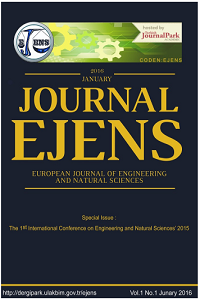An Alternative Method for Long-Term Land Cover Change Detection: A Case Study of Hasanlar Dam
An Alternative Method for Long-Term Land Cover Change Detection: A Case Study of Hasanlar Dam
Land cover change, Dam Hydroelectric power plant, Hasanlar Dam,
___
- Reference1 Öztürk, T., “Çoruh havzası su kaynaklarını geliştirme projelerinin çevresel etkileri,” TMMOB Su Politikaları Kongresi, 2009, s. 220-226.
- Reference2 Baxter R.M., “Environmental effects of dams and impoundments,” Annual Review Ecological Systems, vol. 8, pp. 255-283, 1977.
- Reference3 Kocabaş, M., Başçınar, N., Kutluyer, F., Önder, A.,”HES’ler ve balıklar,” Türk Bilimsel Derlemeler Dergisi, 6(1), s.128-131, 2013.
- Reference4 Yurtseven, İ., “Nehir Tipi Hidroelektrik santrallerin havzalar üzerindeki ekohidrolojik etkileri,” Journal of the Faculty of Forestry, Istanbul University, 61(1), s. 55-62, 2011.
- Reference5 “Dams and devolopment: A new framework for decision-making,” The Report of the World Commission on Dams, London, Uk, Earthscan Publications, 2000.
- Reference6 Dynesius, M. and Nilsson C., “Fragmentation and flow regulation of river systems in the northern third of the world,” Science, vol. 266, pp. 753-762, Nov. 1994.
- Reference7 Berkün, M., Aras, E. and Koç, T., “Barajların ve hidroelektrik santrallerin nehir ekolojisi üzerinde oluşturduğu etkiler,” TMH- Türkiye Mühendislik Haberleri, 6(452), pp. 41-48, 2008.
- Reference8 Aksungur, M., Ak, O., Özdemir, A., “Nehir tipi hidroelektrik santrallerin sucul ekosisteme etkisi: Trabzon örneği,” Journal of Fisheries Sciences, 5(1), pp. 79-92, 2011.
- Reference9 Lovett, R.A., “As salmon stage disappearing act, dams may too,” Science, vol. 284, pp. 574-575, April 1999.
- Reference10 “10 Soruda Hidroelektrik Santraller,” WWF Türkiye Yayını, 2013.
- Reference11 Obahoundje, S., Ofosu, E.A., Akpoti, K. and Kabo-bah, A.T., “Land use and land cover changes under climate uncertainty: modelling the impacts on hydropower production in Western Africa,” Hydrology, 4(2), 2017.
- Reference12 Bewket, W. and Sterk, G., “Dynamics in land cover and its effect on stream flow in the Chemoga watershed, Blue Nile basin, Ethiopia,” Hydrological Processes, vol. 19, pp. 445-458, 2005.
- Reference13 DSİ website. [Online]. Available: http://www2.dsi.gov.tr/baraj/detay.cfm?BarajID=43
- Reference14 Hasanlar HES Proje Tanıtım Dosyası, Ankara.
- Reference15 Zielinski, J., “Watershed Vulnerability Analysis,” Center for Watershed Protection Tech. Rep., 2002.
- Başlangıç: 2015
- Yayıncı: CNR Çevre
Determination of Turbidity in Filyos Stream Water by Artificial Neural Network
Berna AKSOY, İsmail Hakkı ÖZÖLÇER, Emrah DOĞAN, Onur DÜNDAR
Generation of a Multi-Layered Diffusion Coating on an Interstitial-Free Steel
Fikri Erdem Şeşen, Ömer Serdar Özgen
Determination of The Hip Stem Loosening Using Vibration Method
The Usage of Modified Chitosan for the Removal of Hexavalent Chromium from Waste Water
The Abrasion Resistance of Mortars Containing Natural Zeolite Analcime
Yahya BOZKURT, Adnan TÜRKER, Gamze SOYTEMİZ, Serdar SALMAN
Development of Ecological Biodesign Products by Bacterial Biocalcification
Tuğba Keskin Gündoğdu, İrem DENİZ, Alpcan ARİC, Burak Talha YILMAZSOY, Ozge ANDİC CAKİR, Aysegul ERDOGAN, Didem ALTUN, Ayca TOKUC, Burcu Filiz DEMİRCİ, Aylin SENDEMİR, Gulden KOKTURK, Feyzal Ozkaban
Wastewater Treatment by Floating Macrophytes (Salvinia Natans) Under Algerian Semi-Arid Climate
Laabassi AYACHE, Boudehane ASMA
Investigation of Notch Root Strain Behaviors Under Combined Loadings
Toros Arda AKSEN, Emre ESENER, Mehmet FIRAT
An Alternative Method for Long-Term Land Cover Change Detection: A Case Study of Hasanlar Dam
